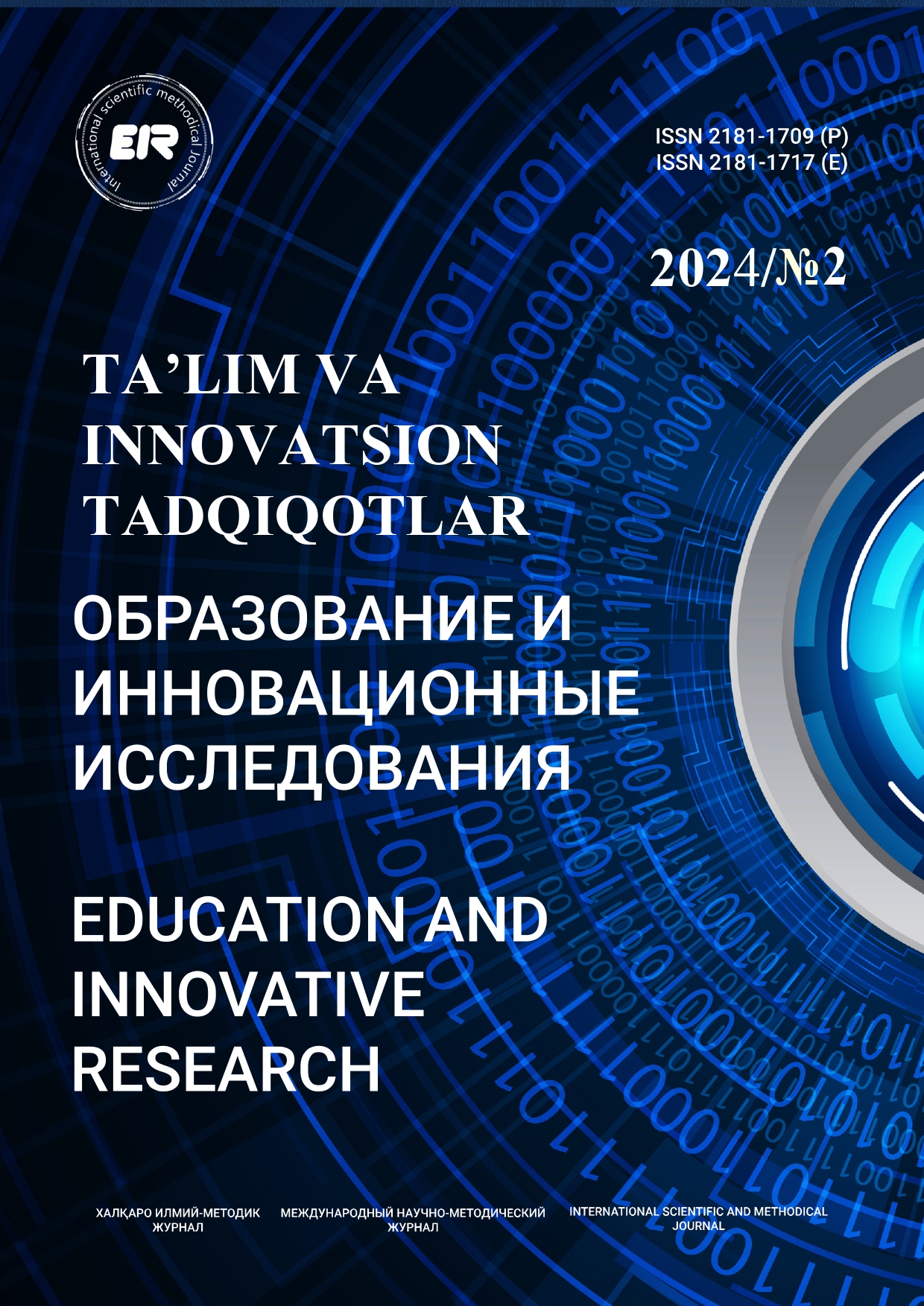CRITICAL THINKING THROUGH READING: QUESTION-ANSWER RELATIONSHIP (QAR) STRATEGY APPLICATION
Mardanova Zilola, Teacher at Uzbekistan State World Languages University, Tashkent city, Uzbekistan.
Keywords:
ability, critical thinking, reading comprehension, strategy, Question Answer Relationship (QAR) strategy, instruction, cognitive skills.Abstract
Students studying English as a Foreign Language (EFL) need to be able to comprehend English text and think critically during the learning process. However, it is a common phenomenon among teachers in the teaching and learning process that these two essential abilities continue to be problems for students. In fact, using an inappropriate teaching strategy is one of the primary causes of the problems. The study aimed to investigate the effectiveness of the Question Answer Relationship (QAR) Strategy by addressing three research questions. The QAR strategy was used during regular reading sessions for a insert duration in both experimental and control groups. As a result, the strategy has significantly improved students’ reading comprehension and critical thinking skills.
References
Arisoy, B., Aybek, B. (2021). The effects of subject-based critical thinking education in Mathematics on students’ critical thinking skills and virtues. Eurasian Journal of Educational Research, 92, 99–120. https://doi.org/10.14689/ ejer.2021.92.6.
Bakhtiari Moghadam, Z., Haddad Narafshan, M., & Tajadini, M. (2021). Development of a critical self in the language reading classroom: An examination of learners’ L2 self. Thinking Skills and Creativity. https://doi.org/10.1016/j. tsc.2021.100944.
Beck, I.L. and McKeown, M.G. (2007) ‘Increasing young low‐income children’s oral vocabulary repertoires through rich and focused instruction’, The Elementary School Journal, 107(3), pp. 251–271. doi:10.1086/511706.
Davies, M. (2013). Critical thinking and the disciplines reconsidered. Higher Education Research & Development, 32(4), 529–544. https://doi.org/10.1080/ 07294360.2012.697878.
Duke, N.K. and Pearson, P.D. (2002) ‘Effective practices for developing reading comprehension’, What Research Has to Say About Reading Instruction, pp. 205–242. doi:10.1598/0872071774.10.
Gollan, T. H., Montoya, R. I., Cera, C., & Sandoval, T. C. (2008). More use almost always means a smaller frequency efect: Aging, bilingualism, and the weaker links hypothesis. Journal of Memory and Language, 58(3), 787–814.
Grabe, W., & Stoller, F. L. (2002). Teaching and researching. Allyn & Bacon.
Halpern, D. F. (2014). Thought and knowledge: An introduction to critical thinking. New York, NY: Psychology Press.
Heidari, K. (2020). Critical thinking and EFL learners’ performance on textually-explicit, textually-implicit, and script-based reading items. Thinking Skills and Creativity. https://doi.org/10.1016/j.tsc.2020.100703.
Izura, C., & Ellis, A. W. (2004). Age of acquisition efects in translation judgement tasks. Journal of Memory and Language, 50(2), 165–181 Ketabi, S., Zabihi, R., & Ghadiri, M. (2012). Critical thinking across the ELT curriculum: A mixed methods approach to analyzing L2 teachers’ attitudes towards critical thinking instruction. International Journal of Research Studies in Education, 2(3), 15–24.
Kintsch, W. (1993) ‘A comprehension-based approach to learning and understanding’, Psychology of Learning and Motivation, pp. 165–214. doi:10.1016/s0079-7421(08)60297-2.
Kintsch, W. (1998). Comprehension: A paradigm for cognition. Cambridge university press.
Kintsch, W., & Van Dijk, T. A. (1978). Toward a model of text comprehension and production. Psychological Review, 85(5), 363–394.
Lai, E. R. (2011). Critical thinking: A literature review. Pearson’s Research Reports, 6, 40–41. https://images. pearsonassessments.com/images/tmrs/ CriticalThinkingReviewFINAL.pdf.
Le, B., & Hockey, J. (2022). Critical thinking in the higher education classroom: Knowledge, power, control and identities. British Journal of Sociology of Education, 43 (1), 140–158. https://doi.org/10.1080/01425692.2021.2003182.
Marin, M.A., & de la Pava, L. (2017). Conceptions of critical thinking from university EFL teachers. English Language Teaching, 10(7), 78–88.
Moghadam, B., Narafshan, H., Tajadini, M. (2023). The efect of implementing a critical thinking intervention program on English language learners’ critical thinking, reading comprehension, and classroom climate. Asian Pacific Journal of Second and Foreign Language Education. 8:15 https://doi.org/10.1186/s40862-023-00188-3.
Moore, T. (2011b). Critical thinking and disciplinary thinking: A continuing debate. Higher Education Research & Development, 30(3), 261–274. https://doi.org/ 10.1080/07294360.2010.501328.
Moore, T. J. (2004). The critical thinking debate: How general are general thinking skills? Higher Education Research & Development, 23(1), 3–18. https://doi.org/ 10.1080/0729436032000168469.
Moore, T. J. (2011a). Critical thinking: History, definitions, issues. Critical thinking and language: The challenge of generic skills and disciplinary discourses (pp. 7–38). London: Bloomsbury Academic, 1 ed. https://www.bloomsburycollections. com/book/critical-thinking-and-language-the-challenge-of-generic-skills-anddisciplinary-discourses/ ch2-critical-thinking-history-definitions-issues.
Nassaji, H. (2011). Issues in second-language reading: Implications for acquisition and instruction. Reading Research Quarterly, 46(2), 173–184.
Perfetti, C. (2007). Reading ability: Lexical quality to comprehension. Scientifc Studies of Reading, 11(4), 357–383.
Petek, E., & Bedir, H. (2018). An adaptable teacher education framework for critical thinking in language teaching.
Thinking Skills and Creativity, 28, 56–72.
Raphael, T. E. (1986). Teaching question answer relationship, revisited. The Reading Teacher, 39(6), 516-522.
Snow, C. (2002). Reading for understanding: Toward an R&D program in reading comprehension. Rand Corporation.
Tan, C. (2017). Teaching critical thinking: Cultural challenges and strategies in Singapore. British Educational Research Journal, 43(5), 988–1002.
Willingham, D. T. (2008). Critical thinking: Why is it so hard to teach? Arts Education Policy Review, 109(4), 21–32. https://doi.org/10.3200/AEPR.109.4.21-32.
Xuelian Li, Jianda Liu, Validating a critical thinking ability questionnaire for EFL learners, Thinking Skills and Creativity, Volume 51, 2024, 101442, ISSN 1871-1871, https://doi.org/10.1016/j.tsc.2023.101442. (https://www. sciencedirect.com/science/article/pii/S1871187123002109).
Yuan, R., Liao, W., Wang, Z., Kong, J., & Zhang, Y. (2022). How do English-as-a-foreign-language (EFL) teachers perceive and engage with critical thinking: A systematic review from 2010 to 2020. Thinking Skills and Creativity, 40. https://doi.org/10.1016/j.tsc.2021.100832.
Yuan, R., Yang, M., & Lee, I. (2021). Preparing pre-service language teachers to teach critical thinking: Can overseas field school experience make a difference? Thinking Skills and Creativity, 40, Article 100832 (2021), Article.
Zhang, H., Yuan, R., & He, X. (2020). Investigating university EFL teachers’ perceptions of critical thinking and its teaching: Voices from China. The Asia-Pacific Education Researcher, 29(5), 483–493.





